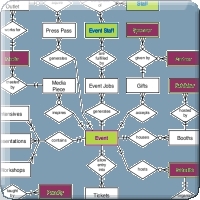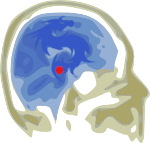
This is a concept that is actually really simple.
Organization has a root word: organ. So does organism. This shared root is not accidental. In this case, an organ is an entity with a specific function.
You are an organism, and inside your body you have organs. Your lungs are meant to do something different than your heart is. But they both work together. The larger system of your body has sub-systems within it that work together to promote life.
Organizations are similar. The development department does something very different than the marketing department, but they work together with other departments and staff members and roles to further the overall mission of the organization. Because the scale of an organization is larger than that of an individual, it can be instructive to view the organization as an ecosystem within other larger ecosystems.
Mapping your Ecosystem

When looking at an Organization as existing in an ecosystem, we are looking at two different ecosystems.
The first is an internal ecosystem composed of various staff, the board, members, students, and other stakeholders who are already actively engaged in the work of the organization.
The second is the external ecosystem of the community in which the organization exists. That could include nearby businesses, other organizations who interact with or do similar things as yours, potential students/clients/members, funders, etc.
Similarly to natural ecosystems the different stakeholders in the internal and external organizational ecosystems exchange resources, information and services between one another.
These stakeholders and resource flows can be drawn out physically as a diagram or map.
In a natural ecosystem, the health of that ecosystem can be measured by the extent to which the exchange of resources is reciprocal, or can be said to exist inside a 'closed loop'.
I scratch your back, you scratch mine.
Closed Loops in an Organization
Identifying and closing resource and information flows within your organization can uncover opportunities and alliances that were otherwise invisible.
For example, let's say you have an organization that acts as a reservoir of information about a given topic, and that you are struggling to pay your bills.
Let's say that 100% of your money comes from 'soft money' sources like grants and support from philanthropic organizations who understand the value of your organization as an important resource.
An example of an existing closed loop flow of resources/information is your foundation support. They give you money, and in exchange, you agree to try your best to exist and keep doing what you are doing, and send them a report once a year about it.
The one closed resource loop in this case is working, but the issue is that there are others that can be exploited to the benefit of your mission.
For example, let's say you were able to identify different groups of people in your environment who benefit from the existence of your information and your organization.
In this case, let's say that you are an expert in plant care and preventing plagues.
Part of the money you receive is from state and local government whose employees use your research into local plagues in order to understand how to handle situations that are questionable and prevent large scale loss of local production from plagues.
Although local residents also use and would benefit from your resources, you have not yet 'closed' the resource flow with this population. What would closing that flow look like? It could look like providing a class for local gardeners. It could look like teaching a course in the community college. It could look like creating and selling booklets or pamphlets.
The point is that you put a little energy into formalizing a service or product that is interesting to this population and that can be promoted through the networks used by this population, and essentially you open up an income stream that is no longer 'soft' by 'formalizing' and 'closing' the resource flow with that population.
In doing so you ideally generate enough income to justify the energy expended creating and promoting the new product/service.
Examples of closed loops in a natural ecosystems (and including human ecosystems)
Example 1: Breathing
- A human being breathes in oxygen, and exhales (as waste) carbon dioxide.
- At the same time, trees and other plants are 'breathing' in carbon dioxide, and 'exhaling' oxygen.
This exchange can be said to exist in side of a closed loop. This loop doesn't have to be direct.
Example 2: Fertilization and propagation
Let's take the case of a mulberry tree, and bird, and the soil (which is a whole community of a lot of micro-organisms).
- A bird eats the mulberries from the tree, and as she is eating them passes the digested mulberries onto the ground (and into the soil) as waste.
- We say "yuck", but the micro-organisms in the soil say "yummy", and they eat the waste of the bird, and in turn create their own waste.
- Which is lucky for the Mulberry tree, because it's roots cannot uptake the waste from the birds directly. They have to be eaten, digested and excreted as waste by the micro-organisms before their little root hairs can absorb them.
Without these closed loop exchanges, an ecosystem cannot sustain itself.
Example 3: Matching human needs
Let's take the case of an elderly quadriplegic with an active mind, and just about anyone who needs practice with a presentation.
- One of the elderly quadriplegic's chief health concerns is BOREDOM.
- Plenty of folks have something or other they will need to present to someone.
- What if there was a 'class' schedule that was open to the community and advertised whereby folks who needed to make presentations might present to the quadriplegic person in their home.
Without these closed loop exchanges, an ecosystem cannot sustain itself. I know I said that above, but I want you to think about that again, in a different way, for this example.
Example 4: Creating useful exchanges and building community
Let's take the case of the person with a good job but no time to cook, and a person with an availability to cook and a need for additional income.
- The exchange is obvious, but how can it happen?
- Do they cook live meals that the other person attends?
- Are they packaged up for consumption somewhere else later?
- Are they picked up or dropped off?
Without these closed loop exchanges, individuals have a hard time sustaining themselves.
Example 5: Mentorship
The mentorship relationship is an interesting ecosystem with a closed Loop. While on the outset it would seem that the person being mentorred is getting the most out of the exchange, that is not actually the case if you count non-material gains such as feeling useful and important, and knowing you are contributing to someone in an important way.
- Non-material exchanges are where the gold is. If you can find them and use them, your endeavor will prosper.
- As important as valuing these non-material gains, is to not over value them. A volunteer is not a slave. They have feelings and needs.
- A culture in which the learned do not give back to the youth and the future is a doomed culture, just as an ecosystem that cannot fully utilize the wealth around it will eventually not be able to sustain itself.
Without these closed loop exchanges, individuals have a hard time sustaining themselves - be they plants, humans, or animals.
Mapping Works
It works in large part because instead of going over the same issues in your mind over and over again and personalizing them, you are putting it on paper, and are able to see a birds eye view that was not available before.
When you view the resource flows from this perspective, it becomes very apparent which of them is not working.
To find out more, fill out the contact form or email me directly at ana(at)jellobrain.com.
